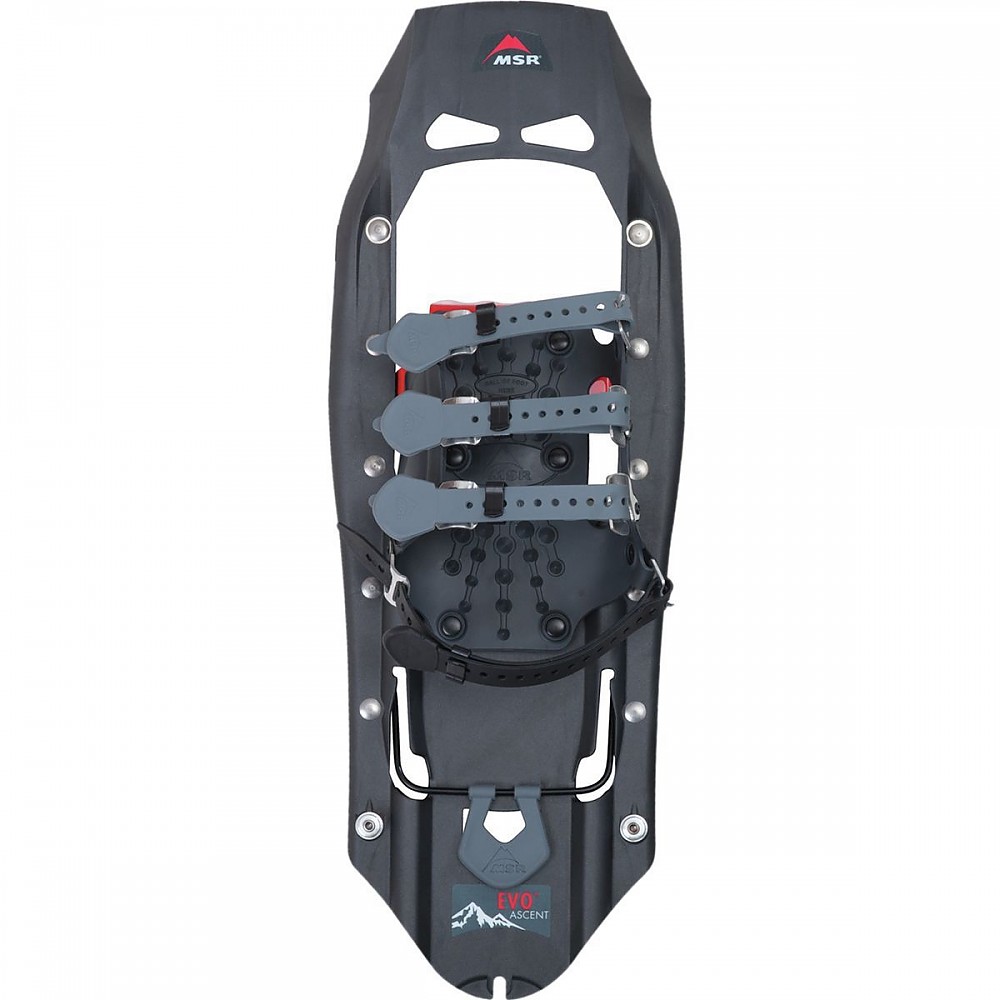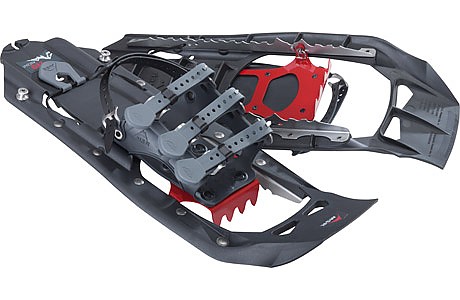MSR Evo Ascent

Indestructible white plastic snowshoes that have good gripping and are easy to put on with mittens and are great for off-trail use.
Pros
- Lighter than most snowshoes
- Very rugged
- Extendable — separate tails can be added for heavy loads
Cons
- Older models have not-so-easy-to-attach bindings
Easy to put on and take off without taking off your mittens.
These are the best snowshoes for off trail use — map and compass stuff — work well in the forest.
These MSR EVO ASCENT snowshoes have three binding straps and televators. The trail EVO models have two binding straps and no televators. Great for beginning but not good for large steep hills and mountains.
Used these over the years in the White Mountain National Forest (WMNF) in N.H. and once over a blizzard weekend on a winter backpacking trip on the Long Trail in Vermont. They work OK (sort of) as a second shovel digging out the car that the Vermont snowplows completely buried. Good thing we had a bright orange ball on the antenna top huh?
Early in winter, the snow cover is usually less than a foot deep. This means that all the bushes, vines, thorny creepers and brambles are all just waiting to catch or grab on to you. These white plastic and metal snowshoes are small enough to allow you to maneuver thru the brambles. You can back out the stuck foot when you have slid the front under vines that have bowed over forming loops. You can't easily do that with long snowshoes.
Peak Baggers — I see these and MSR Lightning Ascent models worn by peak baggers. The AMC has a patch for climbing all of the 4000 foot high mountains in the winter. Not too many try to get this. Only 4000 feet? People out west just don't realize how insanely bad the weather conditions get when you go past the tree line. These snowshoes work OK on smooth round slimy rocks with a 1/2 inch of ice covering over them.
Your choice is these type of snowshoes or Tubbs with the replacement huge snowshoe cleats or 10- or 12-point crampons, YAKTRAX, MicroSpikes, etc. Not sneakers as I have seen worn by hikers at the end of November that were headed down from Mount Washington summit.
These snowshoes do bog down a bit when you are carrying an 85-pound pack. Mid winter perhaps bigger snowshoes may be better for heavy packing.
Here is a TNP YOUTUBE video from NUTNFANCY
Late in winter, when there's lots of melting snow, lots of wet ice in between all the dry patches, these snowshoes work really well. I thought they would get ruined crossing the salted frozen dirt roads or dry patches but these durable snowshoes don't mind these dry spots at all.
Source: bought it new
Price Paid: $189 and free shipping
Great technical snowshoes that are still fun for a simple day on the trail.
Pros
- Durable
- Great bindings
- Heel lifters!
- Great traction
Cons
- Not for the fluffiest of powder/heaviest of people
- Can be loud (crunch crunch crunch)
MSR Evo snowshoes are bombproof. They don't break under normal use, and I can't imagine what kind of abuse you'd have to put them through in order to damage them.
The design is great for climbing (attention fellow peak-baggers). They're plastic, so the same main body of the snowshoe that keeps you afloat is also molded to give you traction. The metal crampons and traction bars are aggressive enough for all snowshoeing situations. The heel lifters are absolutely essential for any sort of climbing.
These snowshoes are also amazing for recreational use, especially since you can add tails. They work great for me in the fluffy Colorado snow, but if I was any heavier I'd have to look at a different brand. The tails are especially nice since they make the same snowshoes work for different sized people.
I highly recommend giving these snowshoes a try. You will feel superior to your friends with their metal and rubber snowshoes, which seem like old wooden trapper snowshoes in comparison.
Source: bought it new
Price Paid: $200
Technical ascents (angled, icy terrain) are much easier with these lightweight, strong snowshoes. If you want to move fast and get above the crowds, these are the shoes for you.
Pros
- Strong
- Lightweight
- Exceptional traction
Cons
- Too small for deep powder with a heavy pack
The design of these snowshoes is clearly targeted to climbers and mountaineers. And, they are equally at home on packed, icy winter hiking trails. Where they aren't enough is in deep powder with a heavy pack. There, you need a bigger footprint.
The tails work well enough, and I like the narrow width which keeps them comfortable and cuts down on the trips and catches that wide shoes can cause. The binding system is simple and reliable. No frozen fingers futzing around with slipping straps mid-trip. I think these would be good loaners for friends because they're likely to come back undamaged and fit different sized feet easily.
The main reason I bought them is the traction and light weight and that's where they excel. Side slipping just doesn't happen and up, down, and sideways over icy terrain are all the same - secure and confident. They fit on the pack easily when not in use.
Source: bought it new
Design flawed. Not durable or reliable, but comfortable, until the straps break. ALL of them. Apparently MSR are aware straps degrade and break over time and they are all right with that. Not me.
Pros
- Comfort
- Versatility
Cons
- Straps break easily after the rubber straps degrade into
Buy a more reliable set of snowshoes. Do not waste your money on these. It’s dangerous to have a strap break in the backcountry.
During the third season of use (about 15 days total use) ALL plastic straps on both snowshoes broke. Stretchy rubbery straps degrade over a couple years into brittle hard plastic easily breakable garbage. The straps are a clear design flaw that MSR has admitted to but still wants $30 for replacement straps, that will probably last two seasons.
I have a pair of Tubbs snowshoes that are 15 years old, still going strong.
Two stars because for the first two seasons they were comfortable, easy to put on, and have removable flotation tails for deep powder. But they are not durable or reliable and definitely not designed well. Do better, MSR. Don’t tell me to live with it.
Background
MSR usually quality gear except in this case. Disappointed for sure. Bad customer service.
Source: bought it new
Pretty lightweight, good floatation, Televators are worth the upgrade. The bottom of the plastic deck does wear down easily.
Pros
- Pretty lightweight
- Good floatation
- Televators are worth the upgrade.
Cons
- After only two hikes, the plastic has already started to get scraped down.
Overall might be the best snowshoe for the price, just a little concerned about the wearing down of the plastic though.
Source: bought it new
Price Paid: $160
Your Review
Where to Buy
You May Like
The Evo Ascent replaced the MSR Denali Ascent.
Specs
| Price |
MSRP: $199.95 Current Retail: $179.96-$259.95 Historic Range: $129.93-$259.95 Reviewers Paid: $160.00-$200.00 |
| Weight |
4 lb 1 oz / 1845 g |
| Length |
22 in / 56 cm |
| Width |
8.2 in / 20.3 cm |







